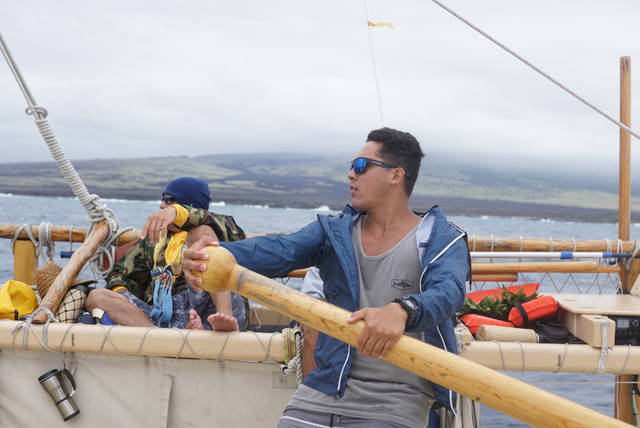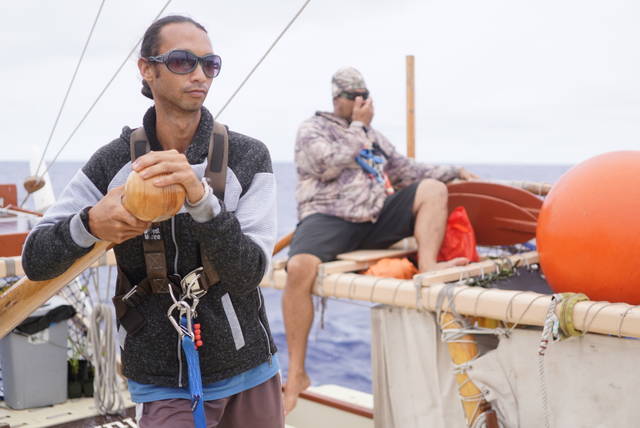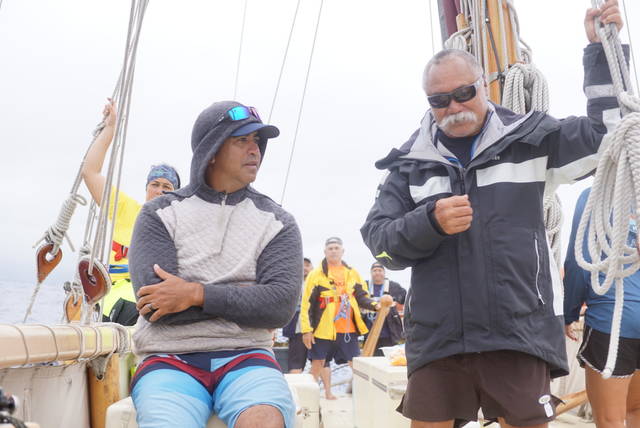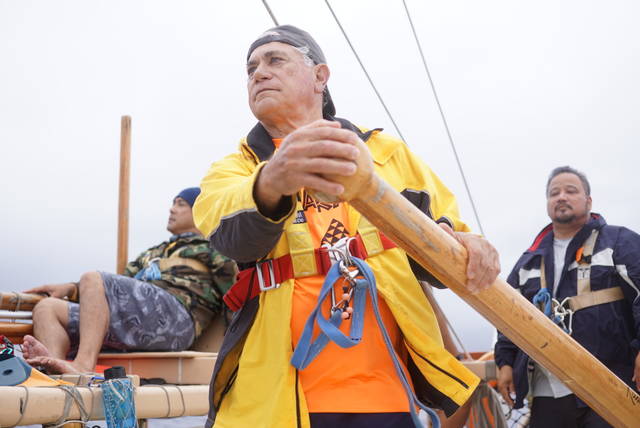Aboard Hokule‘a

Kaniela Anakalea-Buckley steers Hokule‘a during a voyage from Miloli‘i to Kawaihae Sunday. (Cameron Miculka/West Hawaii Today)

Will Mae-Huihui steers Hokule‘a during a voyage from Miloli‘i to Kawaihae Sunday.

Kawika Crivello, left, speaks with crew captain Ah Lun Yung aboard Hokule‘a during a voyage from Miloli‘i to Kawaihae on Sunday. (Cameron Miculka/West Hawaii Today)

Pualani Lincoln Maielua, left, speaks with Kaniela Anakalea-Buckley aboard Hokule‘a Sunday. (Photos by Cameron Miculka/West Hawaii Today)

Hokule‘a quartermaster Ma‘ulili Dickson steers the vessel north along the coast of Hawaii Island during a voyage from Miloli‘i to Kawaihae Sunday.
As Pualani Lincoln Maielua steered Hokule‘a into harbor Sunday evening, the call of a pu swept the sea and about a dozen canoes made their way out to greet the incoming crew.
As Pualani Lincoln Maielua steered Hokule‘a into harbor Sunday evening, the call of a pu swept the sea and about a dozen canoes made their way out to greet the incoming crew.
Standing at Hokule‘a’s bow, Will Mae-Huihui, a born-and-raised fisherman of Miloli‘i, pulled a pu from the foremast and sounded a response as paddlers’ voices filled the harbor, their paddles raised to the sky.
But now wasn’t the time for the voyaging crew to rest.
Working quickly, Kawika Crivello pulled in lengths of the tow rope that led out from Hokule‘a’s bow, passing the rope behind him and over the splash guard, where it piled up on the deck. Other crew members, meanwhile, prepared the anchor and chain for their arrival in Kawaihae.
It had been a several-hours voyage since leaving Miloli‘i Sunday morning, led by crew captain Ah Lun Yung of Keaukaha, who first stepped on board Hokule‘a in 1977.
They were looking for new crew at the time, he said, but he had other kuleana to take care of and couldn’t quite commit. But Hokule‘a stayed on his mind and, after he retired from his work as a lineman, he became a member in 2007.
“It was first built to prove that we could sail without instruments and then from that, it just blew up and morphed into sharing,” he said.
Asked what he enjoyed about being a part of Hokule‘a, the captain turned the question around.
“What isn’t there to be appealing, you know what I mean? Just being on the water, and just trying to learn what our ancestors did and try and keep up with tradition,” he said. “Hope to pass it on to the next generation.”
View from aboard
To stand on the deck of Hokule‘a is to stand witness to the natural forces that have shaped Hawaii over countless millennia.
In nearly all directions, a seemingly infinite expanse of blue ocean asks those brave enough to explore what lies beyond the distant horizon.
But before the ceremonial arrival, swell after swell, blown by winds miles away, passed beneath the crew’s feet, each headed inland until they crashed against a cliff or lapped at the feet of a sunbather on the beach. The steady rise and fall of the canoe as swells traveled below its hull made Hokule‘a itself feel like it was breathing as it voyaged north.
As Hokule‘a made its way north, its crew, most of whom took part in the years-long Malama Honua Worldwide Voyage that took Hokule‘a and Hikianalia to communities around the globe, shared what drives them to come aboard, speaking about a common love for the ocean and desire to connect with the traditions of their ancestors.
For Lincoln Maielua, a watch captain, being aboard a sailing canoe connects her to her kupuna as she goes through the same movements on the same ocean and under the same sky.
She’s always loved it, she said, going back to one of her first experiences in a canoe aboard Makali‘i, a sailing canoe based in Kawaihae, and recalled looking back over the water to her island.
“It’s really about this,” she said, looking toward Hawaii Island.
To starboard, the island rises dramatically from the ocean. Although clouds obscure views of the mauna summits, one can imagine them reaching past the sky.
The landscape itself transforms throughout the day, with green forest and farmlands splashed against the earthy slopes and the occasional coastal grove dotting the shoreline.
Now and then, the landscape is broken by enormous lava fields, rivers of once-molten rock that poured toward the coastline, extending Hawaii’s reach into the sea.
“When we see our beautiful island from the ocean, for me, I often think about how our kupuna felt when they first came here,” Lincoln Maielua said. “And how they would feel when they returned back home and how their travels across the sea, their migrations is what bestowed and embedded into them this super strong sense of aloha ‘aina, caring for the land, beyond what I think people describe it as today, but really … as something that is a part of who you are.”
Lincoln Maielua last year took part in the Hawaii Homecoming leg, which traveled from Tahiti to Hawaii, a voyage she said held deep significance for her.
“I always felt like that would be a really significant run for me, from Tahiti to home, to see what our kupuna saw when they got here, and more specifically to see my island, Hawaii Island, emerge from the horizon,” she said.
History relived
The Malama Honua Worldwide Voyage brought Hokule‘a and Hikianalia around the world using ancient navigation techniques. Over the course of the voyage, the canoes were expected to cover 60,000 nautical miles combined and visit more than 150 ports and 23 countries and territories around the world, according to the Polynesian Voyaging Society.
Yung himself took part in the legs that sailed from Tahiti to Samoa by way of the Cook Islands as well as the trans-Atlantic voyage from South Africa to Brazil.
He said every one of those ports they pulled into was an important part of the voyage. Not only was it a chance to educate people about the canoes and Hawaiian traditions, it also invigorated others to explore their own traditions, a point also raised by Lincoln Maielua.
“For the people of the world, they too have their legacies of ingenuity and amazing history of their own ancestors as well,” she said, “and I think if everybody kind of reached back to that and believed in that to a point where it empowered them on a day-to-day basis, then we would all be in a better space as a honua, as a world.”
For the Worldwide Voyage and Hokule‘a to cultivate that sense of pride for not just Hawaii, but the whole world, she added, “is just amazing.”
“That is her mana,” she said. “She has this amazing mana about her; she’s able to bring people together to highlight people’s strengths, to make dreams come true.”
The vantage point from the water offers a wide-lens view of how these days, the landscape continues to be shaped by the people who live on it and how they have incorporated the island’s natural features into their communities and integrated themselves into their surroundings.
North of Kealakekua Bay, a golf course drapes around Pu‘u Ohau, the boundary marker between Kona Hema and Kona ‘Akau. And at Keahole Point, airplanes take off from and land on runways partially built over lava that flowed a decade before the unification of the Hawaiian Islands.
The crew also included quartermaster Ma‘ulili Dickson, who’s been a part of Hokule‘a’s story since the start.
When Hokule‘a started in the 1970s, he said, his cousin Nainoa Thompson asked for his and others’ help with the canoe so he could do night trials in the Kaiwi Channel outside Koko Head and Diamond Head on Oahu, while Thompson was learning the stars and navigation.
But his love for canoes goes back much further.
With his grandfather’s help, Dickson built his first canoe at 7 years from a folded piece of iron roofing, a couple 2-by-4s at each end, hau branches for the ama and ‘iako and another board in the middle to spread the hull.
And like the rest of the crew aboard Hokule‘a, Dickson said he has “a lot of aloha for the canoe,” saying it’s an icon for “all Hawaiians and all people of Hawaii” and proves the culture can be revived.
“We’re so wrapped up in the Western way of life, and American way of life, we don’t carry the aloha like the Hawaiians used to. So we need to get back to that, and Hokule‘a helps us do that.”
It’s a sentiment also shared by Mae-Huihui, who said Hokule‘a represents a “bridging of the gap” between past generations and teaching the “hard-head” generation of now about humility and how to “strive for a more pono future.”
“We need to humble ourselves and look back to the past as well as the future,” he said. “You look to your past to understand your future.”
The 29-year-old Miloli‘i man grew up on the water and for him, it’s always a chance to “unplug to recharge,” as well as to “disconnect from the digital world and reconnect with the old-school world.”
“I feel more, I’m grounded, more open-minded, more relaxed, not as anxious,” he said. “And I feel like I’m just a better person when I’m out on the water and in the ocean.”
Both Dickson and Yung spoke about the crucial role young people have in perpetuating the story of the more-than-40-year-old Hokule‘a as Hawaii continues into the future.
“We want her to go 40 more years,” Yung said. “So, we need the children, the next generation to take over.”
The next generation
Among those youth was Kaniela Anakalea-Buckley, 22, of Waimea, who got his start sailing with Makali‘i as a fifth-grader, where he trained and, in 2014, he was asked to join the Hokule‘a crew from Tahiti to the Cook Islands and on to Samoa, the “voyage of reconnection.”
He turned 19 during that voyage and said he was honored to sail alongside people like John Kruse and Billy Richards, who took part in the 1976 Hawaii-Tahiti sail, and learn the stories of that journey.
“It was really just an amazing opportunity to get to be a part of that particular leg,” Anakalea-Buckley said.
Sailing to places in the region like the Cook Islands demonstrated for him the unifying experiences of people who make their homes throughout the Pacific, where resources are finite and everyone shares the same space as well as a love of the ocean.
“Those are the cool things of visiting those specific islands, is that they’re so similar to home, it made us feel like we were home,” he said.
Dickson said he enjoys seeing youth like Anakalea-Buckley taking on roles as teachers to share Hokule‘a’s story.
“It’s good, because then you know that the culture is going to not only live on, but it’s going to improve,” he said. “Because these young ones have better education than we had. They’re exposed to more things, so they can relate to anybody, any individuals, not just kids or young people — young students. They have more ability to transfer this on.”
And as the Mahalo, Hawaii Sail continues to bring Hokule‘a to communities throughout Hawaii, crew members credited the voyage’s success to the local communities that never stopped supporting their mission.
Dickson acknowledged the “ground crew” — made up of groups like hula troupes, nonprofits, civic clubs and societies — that makes the voyages possible.
“They all support the canoe on land, so when the canoe comes to an area, they’ll bring food, they’ll bring supplies or they’ll help transport things,” he said. “It’s a whole community coming to support the canoe.”
Celebrating the voyage
That’s what happened in Miloli‘i — like it would several hours later in Kawaihae — where community members came together to feed the crew, house them and stay up to keep watch over the canoe.
And that’s true for any of the canoes and any community in Hawaii, Dickson noted.
“The whole community comes out,” he said, citing a recent voyage by Makali‘i to Hana, Maui. “And they don’t get on board, but they just want to see it. They just want to be there and feel the canoe, and they’ll sit along the shore all day long just watching the canoe.”
“It’s the spirit of their ancestors, it’s the spirit of our future, and it’s the spirit of the aloha that we have as a people.”
And it’s the people back home who have constantly supported that spirit and the canoe’s mission, Lincoln Maielua said, to whom the honor belongs.
“A lot of times the glory is focused on the ‘aukai or the voyagers,” she said. “But the truth is that Hokule‘a sailing around the world? The success of that, the ones who should really be honored is Hawaii, the people of Hawaii for supporting her to go — letting her go, supporting her to go — and then bringing her back home safely.”



We should bring back Kon Tiki and have inter Island races!